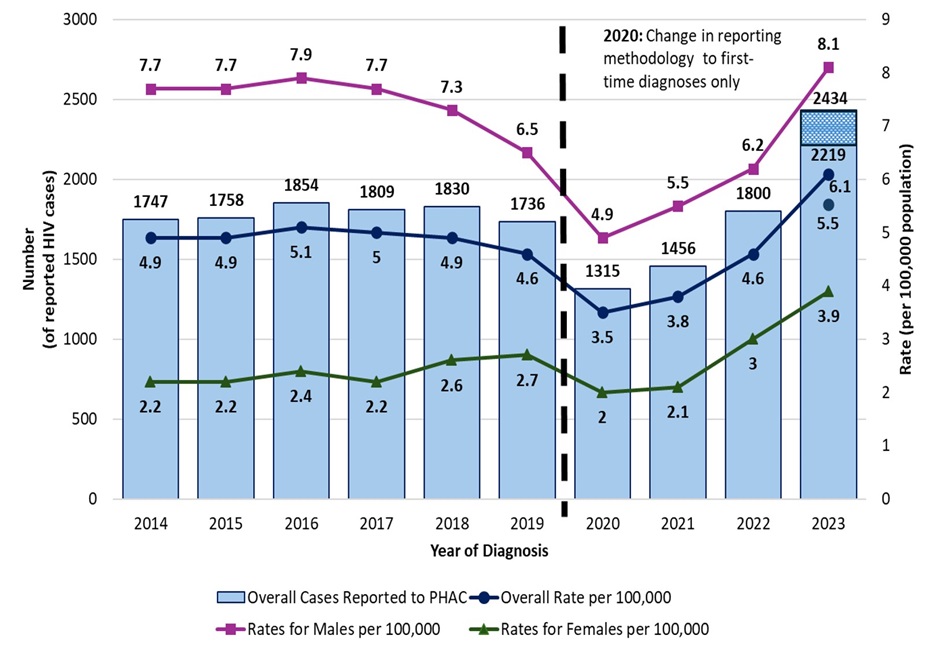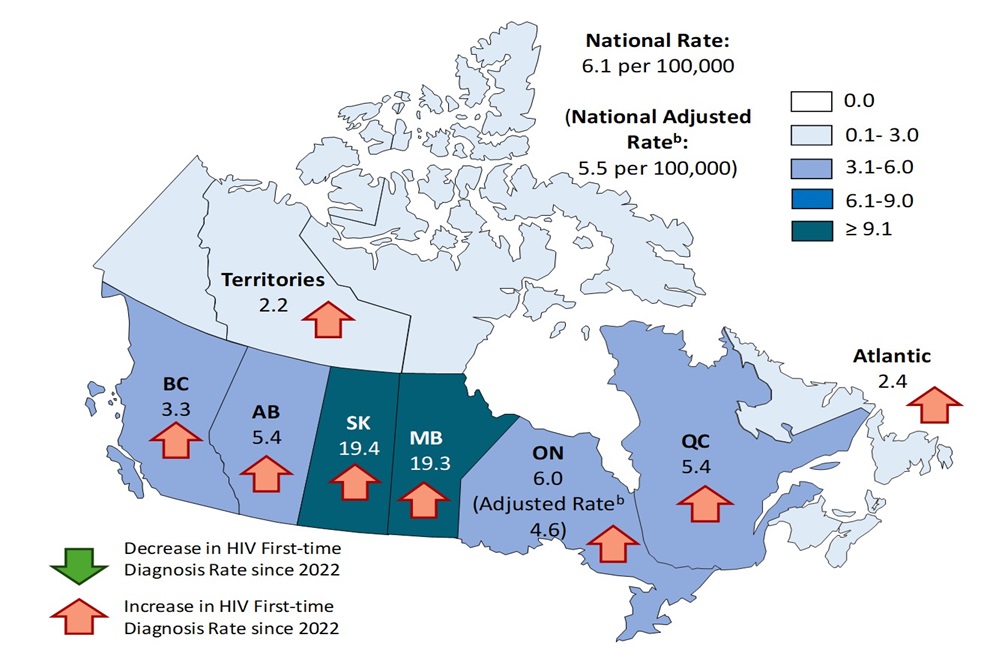HIV in Canada, Surveillance Report to December 31, 2023: Executive summary
On this page
Overview
The HIV in Canada, Surveillance Report to December 31, 2023, published by the Public Health Agency of Canada (PHAC) presents and describes national epidemiological trends on Human Immunodeficiency Virus (HIV) diagnoses in Canada by geographic region, age at diagnosis, sex, race and/or ethnicity, and exposure category between 2014 and 2023. This surveillance report presents information on first-time diagnoses from all thirteen provinces and territories (PT), and provides robust evidence for the planning, evaluation, and implementation of HIV prevention and care programs and education. This report also presents information on first-time HIV diagnoses and previously diagnosed HIV by province and territory for 2020 to 2023 for the planning of effective treatment programs and monitoring Canada's progress toward our 95-95-95 targets.
The COVID-19 (SARS-CoV2 / Coronavirus Disease 2019) pandemic had impacts, both known and unknown, on access to HIV testing, prevention, and care services as well as on surveillance activities in Canada. For this reason, data for 2020-2023 should be interpreted with caution. The true impact and lasting effects of the COVID-19 pandemic on HIV transmission in Canada may become clearer with continued data collection and analysis in the years to come. Due to surveillance data being refined by PTs over time, as data are periodically reviewed and updated, surveillance data for previous years may also be reported by provinces and territories along with the current year's dataset. As such, historical data presented in this report does not exactly match historical data presented in previous national reports.
Additionally, in 2024, Ontario conducted a retrospective project to improve data completeness for first-time HIV diagnoses in 2023. Following this project, the number of first-time diagnoses in Ontario in 2023 reduced from 938 to 723. Importantly, this report uses the initial count of 938 for Ontario in 2023 for national reporting to allow for comparability over time, and as such, it will have some impact on all analyses presented for 2023 (e.g., overestimating counts and rates). Please refer to the Ontario HIV Epidemiology and Surveillance Initiative (OHESI) website for more information on first-time diagnoses in 2023 and the methodology of the HIV Look Back project.
Key findings
Key findings include:
- In 2023, 2,434 newly diagnosed cases (i.e., no previous evidence of a positive test) of HIV were reported in Canada. This is an increase of 35.2% compared with 2022 (1,800 reported cases). This increase may be due, in part, to renewed access to HIV testing services in the later stages of the COVID-19 pandemic and increasing immigration volumes from across the globe (after pandemic restrictions were lifted). Social determinants of health and epidemiological patterns place some migrants (immigrants, temporary residents, and refugees) at greater risk of HIV infection before and after they arrive in Canada. While the volume of immigration has increased post-pandemic (2021 onwards), the proportion of positive HIV tests during an Immigration Medical Exam (IME) in Canada has also risen, though it remains relatively low (0.37% in 2023 vs. 0.12% in 2021).
- The national rate of reported newly diagnosed HIV cases was 6.1 per 100,000 population in 2023, an increase from 4.6 per 100,000 population in 2022. With the 2023 rate recorded above pre-COVID-19 pandemic levels (4.6 per 100,000 in 2019), it is important to note that the diagnosis rate for 2023 includes only first-time diagnoses while data for years prior to 2020 may include previously diagnosed cases due to evolution in surveillance reporting methods.
- The overall trends of the past ten years show the number of first-time HIV diagnoses in Canada was relatively stable until 2020, with a previous peak of 1,854 cases in 2016 (rate of 5.1 per 100,000 population) decreasing to 1,315 cases in 2020 (rate of 3.5 per 100,000 population), followed by increases in 2021, 2022 and 2023.
- Data received by PHAC from the Provinces and Territories has the sex of cases classified by the mutually exclusive categories of male, female, transgender, or not provided. In some instances, sex and gender may be erroneously conflated in these data. Therefore, data for cases reported as male or female may or may not exclude transgender people, and reporting may not necessarily align with the gender identity of individuals. The National HIV Surveillance System (HASS) is actively working on improving data collection and reporting to better represent gender-diverse communities.
- The national first-time HIV diagnosis rate was 8.1 per 100,000 population in males (male sex) and 3.9 per 100,000 population in females (female sex) in 2023; an increase from rates reported in 2022 (which were 6.2 and 3.0 HIV diagnoses per 100,000 population, respectively).
- Recent trends in the HIV diagnosis rate among males show a continued decline in rates between 2014 to 2020 from 7.7 per 100,000 to 4.9 per 100,000 before increasing to 8.1 per 100,000 in 2023. Among females, the trend shows an increase, peaking at 2.7 per 100,000 females in 2019, decreasing to 2.0 per 100,000 in 2020 and increasing to 3.9 per 100,000 in 2023. The 2023 rates in males and females were above pre-COVID-19 pandemic levels.
- When broken down into age groups, the HIV diagnosis rate in the 30 to 39 years age group was the highest among all age groups with 14.3 per 100,000 population in 2023.
- HIV diagnosis rates were observed to be at least two times greater in males than in females in all age groups, with the exceptions of the children <15 years and the 15 to 19-year age group (both in which the HIV diagnosis rates were similar among sexes).
- The overall national first-time HIV diagnosis rate increased from 2022 to 2023 and this was observed across all regions (groups of PTs). While the increase was observed in the Atlantic region as a whole, not all Atlantic provinces saw an increase.
- The highest first-time HIV diagnosis rate across provinces and territories was in Saskatchewan, with 19.4 per 100,000 population, followed by Manitoba with 19.3 per 100,000 population. The lowest diagnosis rate was in the Territories region with 2.2 per 100,000 population.
- Similar to 2022, the largest proportion of adult HIV diagnoses was attributed to heterosexual contact (39.4%) in 2023. According to reported exposure category, male-to-male sexual contact continues to account for the largest proportion of diagnoses in males (male sex), at 52.2% of diagnoses.
- Heterosexual contact continues to account for the largest proportion of diagnoses in females (female sex), at 68.1% of diagnoses. Injection drug use also remains a significant factor among cases in both males and females, accounting for 18.2% of all first-time diagnoses in 2023.
- Proportion of diagnoses attributable to different exposure categories also varied by age group. In the 20 to 24 year age group, male-to-male sexual contact accounted for the largest proportion of diagnoses (48.6%). By contrast, among 40 to 59 year olds, heterosexual contact accounted for the largest proportion of diagnoses (50.9%).
- Race-based data provides a key element in recognizing and understanding disparities in access to HIV care stemming from historic and ongoing colonialism, racism, and systemic and structural inequities in Canada. However, the reporting of race and/or ethnicity data varies significantly across jurisdictions. Overall, race and/or ethnicity data were reported for only 42.9% of first-time diagnoses in 2023. No race and/or ethnicity data were reported from Manitoba, Nova Scotia and Quebec.
- Among the 1,043 cases of new HIV diagnoses for whom race and/or ethnicity was reported, 27.6% of cases were reported as Black people, 25.1% were reported as white people, and 19.6% were reported as Indigenous Peoples (8.6% First Nations, 0.1% Inuit, 1.0% Métis, or 9.9% Indigenous-not otherwise specified). Given race and/or ethnicity data are not missing randomly, these proportions are unlikely to be representative of all first-time diagnoses and should be interpreted with caution. In collaboration with community members, HASS has established a Black Expert Working Group for National HIV Surveillance and a First Nations, Inuit, and Métis Working Group for National HIV and Syphilis Surveillance to provide advice and co-develop strategies to improve the completeness, interpretation, and contextualization of race and/or ethnicity data.
- While the number of first-time diagnoses increased between 2020 to 2023 for most provinces/territories, the trends in the number of previously diagnosed cases varied. Likewise, the proportions of reported HIV diagnoses attributed to previously diagnosed cases also varied by province and territory.
- Of the 247 infants reported to be potentially perinatally exposed to HIV in 2023, 97.1% were born to people who had received antiretroviral therapy (ART). There were five infants confirmed to have acquired HIV perinatally, three of whom were born to people who did not receive any ART and two of whom were born to people who received some ART.
- An increased number of migrants (immigrants, refugees and temporary residents) tested positive for HIV during an IME in Canada or abroad in 2023 compared with 2022. Data provided by Immigration, Refugees and Citizenship Canada (IRCC) demonstrated that in 2023 the total number of migrants who tested positive for HIV in Canada was 1,645, representing 0.37% of all IMEs in Canada, a proportion higher than pre-pandemic levels (0.24% in 2019). In 2022, 1,032 migrants tested positive for HIV during IMEs in Canada (0.26% of all IMEs in Canada). This indicates the large increase in HIV cases detected among migrants in 2023 was partially the result of increasing immigration volumes and slightly higher HIV test positivity among migrants.
- In 2023, there were 109 cases of Acquired Immunodeficiency Syndrome (AIDS) reported, a continued decrease since 2014. However, findings should be interpreted with caution, as AIDS data were only submitted by four provinces in 2023 (New Brunswick, Nova Scotia, Ontario, and Saskatchewan) and, where this information was available, cases are likely underreported.
- In 2023, there were 126 deaths (0.4 per 100,000 population) attributed to HIV. This represents a decrease, in number only, compared with the 129 deaths (0.4 per 100,000 population) attributed to HIV in 2022, however HIV-related deaths are likely underreported.

Figure 1: Text description
| Year of diagnosis | Overall first-time diagnoses | Overall rate per 100,000 | Males rate per 100,000 | Females rate per 100,000 |
|---|---|---|---|---|
| 2014 | 1,747 | 4.9 | 7.7 | 2.2 |
| 2015 | 1,758 | 4.9 | 7.7 | 2.2 |
| 2016 | 1,854 | 5.1 | 7.9 | 2.4 |
| 2017 | 1,809 | 5.0 | 7.7 | 2.2 |
| 2018 | 1,830 | 4.9 | 7.3 | 2.6 |
| 2019 | 1,736 | 4.6 | 6.5 | 2.7 |
| 2020 | 1,315 | 3.5 | 4.9 | 2.0 |
| 2021 | 1,456 | 3.8 | 5.5 | 2.1 |
| 2022 | 1,800 | 4.6 | 6.2 | 3.0 |
| 2023 | 2,434 (2,219) | 6.1 (5.5) | 8.1 | 3.9 |
Figure 2: Changes in first-time HIV diagnosis rate per 100,000 population, by province or territory, Canada, 2023Endnote dEndnote eEndnote fEndnote gEndnote h

Figure 2: Text description
| Province | First-time HIV diagnosis rate (per 100,000 population) in 2023 | First-time HIV diagnosis (per 100,000 population) in 2022 | Increase or decrease in HIV diagnosis rate since 2022 |
|---|---|---|---|
| Alberta | 5.4 | 4.2 | Increase |
| Atlantic Region | 2.4 | 1.6 | Increase |
| British Columbia | 3.3 | 2.5 | Increase |
| Manitoba | 19.3 | 13.9 | Increase |
| Ontario | 6.0 (4.6) | 3.9 | Increase |
| Quebec | 5.4 | 4.9 | Increase |
| Saskatchewan | 19.4 | 19.3 | Increase |
| Territories | 2.2 | 1.5 | Increase |
| Note: None of the provincial or regional rates decreased between 2022 and 2023. | |||
Full report available
The full PDF version of the HIV in Canada, Surveillance Report to December 31, 2023 is available at: Government of Canada Publications